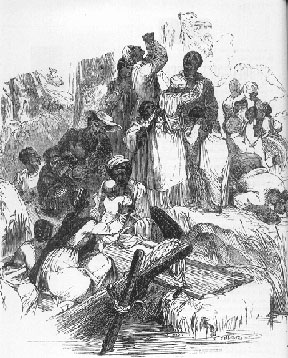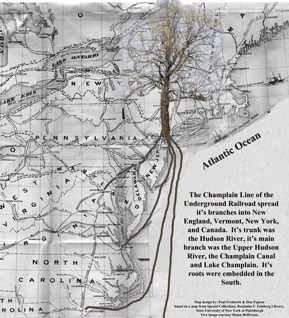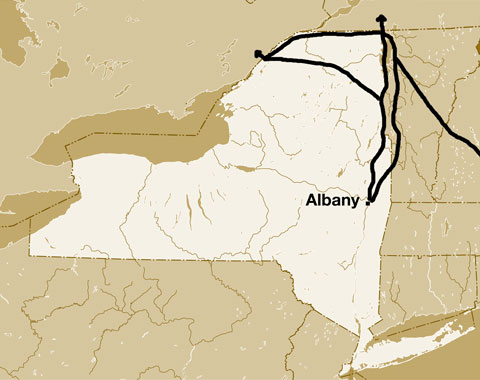By Donald Earl Papson - Founding President,
North Country Underground Railroad Historical Association
SWEET CANAAN'S HAPPY LAND
Oh, my brother, did you come for to help me?
Pray and give me your right hand.
Oh, my sister, did you come for to help me?
Pray and give me your right hand.
Oh, the land I am bound for,
Sweet Canaan's happy land,
I am bound for,
Sweet Canaan's happy land,
I am bound for,
Sweet Canaan's happy land.
Pray give me your right hand.
-Negro Spiritual

Between 1830 and 1860, thousands of enslaved Americans escaped to Canada seeking the sweetness of freedom. Like a majestic maple tree, the Champlain Line of the Underground Railroad spread its branches across Northeastern New York, Vermont and Canada. Its main branch reached up through the Champlain Canal and Lake Champlain to Québec. Side branches extended East to New England and West to Ontario. Its trunk was the mighty Hudson River. The roots of this great tree of liberty were embedded in the South.
In Northeastern New York, the Lake Champlain Corridor provided freedom seekers with a passageway from the Hudson River through New York and Vermont's Champlain Valley to Montreal, Canada. Historically, this geographically determined land/water passageway has been recognized for its critical contributions to American victories in the War for Independence and the War of 1812. Only in recent years have historians begun to realize the importance of the corridor between 1830 and 1860. These were the defining years of the Underground Railroad, that illegal, and sometimes not so secret, network of people who assisted fugitive slaves from the United States on their journey to freedom.
Many New Yorkers and Vermonters were ready to relieve the suffering of freedom seekers. Just before Great Britain abolished slavery in its territories in 1834, American abolitionists, under the leadership of William Lloyd Garrison, organized the American Anti-Slavery Society. Hundreds of chapters were soon organized, with the Vermont Anti-Slavery Society being the first in February of 1835. The New York Anti-Slavery Society was organized six months later. Local societies were formed throughout Vermont and New York. The first men's anti-slavery Society on the New York side of Lake Champlain was started in 1837 in West Peru.
Male and female anti-slavery societies called for immediate abolition, and some of their members became Underground Railroad agents and stationmasters. Agents on the Champlain Line of the Underground Railroad assisted Fugitive slaves in western Vermont and seven Northeastern New York counties—Washington, Saratoga, Warren, Essex, Clinton, Franklin, and St. Lawrence. Throughout the region, agents provided fugitives with food, clothing, safe places to rest and medical attention. Many times they paid for the cost of their transportation to the next station.
The anti-slavery movement united black and white Americans. It was an epic crusade—the first great call for social change in the history of the United States. The collaboration of black and white men and women was critical to the success of the abolition movement and the Underground Railroad.

Of the estimated 100,000 Americans who escaped from slavery in the United States before the Civil War, an estimated 40,000 found refuge in Canada. Thousands of men, women and children made their way to Canada on New York's waterways. Many savored the sweetness of freedom after following the Champlain Line.

Major Champlain Line UGRR routes to Canada






